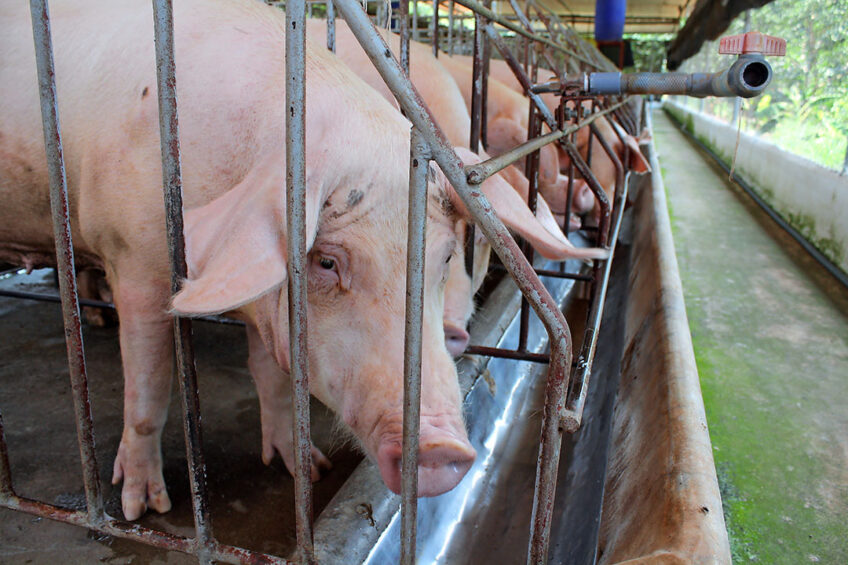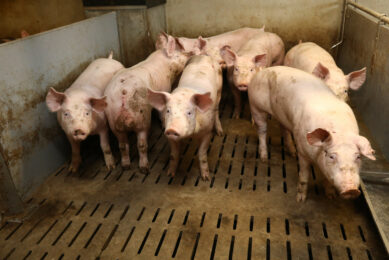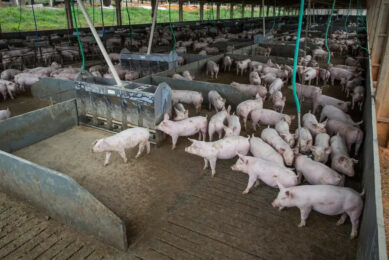Heat stress is not only an environmental issue

The challenge of heat stress is a complex one, and the best way to tackle it is to seek a range of solutions rather than just one. That is why an approach revolving around animal and environmental management should be supplemented by a nutritional strategy.
Pigs are sensitive to heat stress as they are homeothermic animals and have few sweat glands and small lungs. In addition, the focus in genetics for many years has been on increasing performance instead of animals’ resistance and adaptation to different stresses. To adapt to heat stress, pigs first increase their heat dissipation and then reduce heat production.
The first step induces heat loss by conduction and evaporation. The reduction in blood flow to the digestive tract can result in intestinal damage and reduced barrier function, resulting in gut inflammation and reduced nutrient absorption.
The second step, reducing heat production, is brought about through reduced physical activity but also lower feed and water intake. The thermoneutral zone of pigs, illustrated in Figure 1, extends from the lower critical temperature to the point where metabolic rate is actively reduced by heat stress – slightly below the upper critical temperature. The thermoneutral zone is also linked to the humidity level, expressed by the Temperature–Humidity Index (THI). The THI is still the best, simplest and most practical parameter for the measurement of environmental warmth that causes heat stress to animals.
Focus on heat stress impacts in sows
In the US alone, heat stress is estimated to cost $ 900 million per year in swine production, and only half of that loss comes from decreased performance in the grower/finisher phase. The other half comes from impaired performance in the breeding stock, including phases of infertility and decreased milk production. A number of studies have summarised the impacts of heat stress for sows, with identical conclusions. The most challenging time is during the lactation period, when the ideal situation would be to have, in the same pen, two distinct climate zones: a cooler one for the sow to ensure her welfare and thermoneutrality and a warmer one for the piglets.

Even in countries that are not considered hot, sows are suffering from the consequences of heat stress. These sows reduce their feed intake during the lactation period, which can lead to a negative energy balance, a loss of body condition and associated reproductive problems. They are very sensitive to heat stress and use various mechanisms to adapt, which have direct consequences for their own health status but also for that of their piglets. Reduced milk production can impact the weight of piglets at weaning. According to researchers Dr Nathalie Quiniou and Dr Jean Noblet in 1999, a decrease of 55 g/day in piglets’ average daily gain was observed when comparing piglets from sows that were in rooms at 18°C with the ones in rooms at 29°C.
Solutions to deal with heat stress
Nowadays, various solutions are available on the market to reduce heat stress risks, from nutritional solutions to environmental management. In that context, an R&D trial was conducted in a Brazilian commercial farm in São Paulo state in 2020 on two batches of sows for 2.5 months. Two experimental groups (40 sows per group, weaning at 26 days) were compared over the whole lactation period, receiving either a conventional lactating diet or a nutritional strategy developed by Wisium. Sows were exposed to a constant temperature of 28°C throughout the lactation period. In the trial it was observed that the nutritional strategy helped to significantly (P=0.01) limit body losses over the lactation. The average body loss in the control group was 41.2 kg compared to 29.4 kg in the trial group (-11.8 kg). As a consequence of the improved situation of the sows, another clear benefit that was observed was reduced preweaning mortality (from 12.6% in the control group to 5.6% in the nutritional strategy group).
Negative control
During another R&D trial conducted in France in 2019 with a total of 43 sows from day 107 of gestation to weaning at 21 days, the same nutritional strategy was tested against a negative control. In this situation, sows were exposed to high temperatures (28–29°C during the day and 26°C at night). An improvement in average daily feed intake was observed for sows in the group receiving a three-dimensional heat stress strategy approach (+5.36%) for the overall lactation period (see Figure 2). Consequently, backfat and loin depth mobilisation were slightly lower. Also, litter weaning weight was numerically improved by +3.82% in this group. In addition to a better feed intake, a better water intake was also observed: +10.9% for the tested group (34.6 litre/day vs 31.2 litre/day for the control group).

A global approach to heat stress management
Nutritional solutions help in managing heat stress better but cannot be the only approach. A global and holistic approach is key to limiting the negative impacts of heat stress on production. The Wisium solution, Fresh Up, is a three-dimensional concept, which includes different and complementary tools:
- A formulation support which is focused on optimisation of current formulas for better valorisation of feed by pigs under high temperature;
- A connected device which collects environmental data and sends it to a platform so it is available in real time in the user’s hand. The device sends alert messages when environmental parameters are dangerous for animals or staff as well as predictive alerts in anticipation of a heat stress period;
- Technical support based on animal and environmental management.
Once farm management strategies have been implemented, high quality feed additives may be considered as potential solutions for both repair of gut damage and to increase the ability of the animal to cope with this environmental challenge.
Based on the detected risks, Fresh Up provides a nutritional solution to manage that challenge. The solution is a blend of natural and specific ingredients that is formulated to manage the risks of leaky gut and gut inflammation. One of the most effective ways to improve the structure of the gut is with certain additives that activate the sweet taste receptor T1R2/3 in the intestine, which stimulates the release of glucagon-like peptide (GLP-2) from the entero-endocrine cells of the gut. GLP-2 is a potent gastroprotective agent that increases blood flow, stimulates mucosal growth and prevents cell death during challenging conditions. Animals supplemented should have improved gut structure during heat stress but will also recover quicker.











